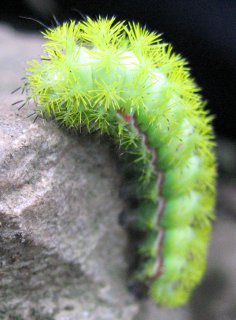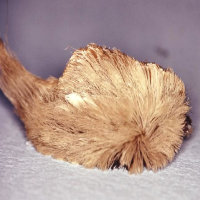“The caterpillar is not so hideous as its venom”, South Florida would say
Community and Forum → Blog → “The caterpillar is not so hideous as its venom”, South Florida would say
Lev Bely, 02.05.2012 22:00

We obviously get more cautious when we spot a wasp, bee or spider. Better take care, anyone could prudently think. Though you may easily add to this “could-be-dangerous” list one more critter that is a bright, colorful caterpillar innocently creeping up your hibiscus tree. Be sure, its venom could bring you most severe pain.
There are four caterpillar species in South Florida having venomous spines to protect themselves from enemies' attacks. As the spring comes, they become to emerge from eggs and try to survive the next few weeks before turning into butterfly or moth.
The Florida Poison Information Center—Miami that registers all contact poisoning accidents either chemical or reptile/insect, got 227 calls from South Florida residents over the past year, all were stung by poisonous caterpillars. Statistics says that the pain such “caterpillar” victims have to suffer is extremely intense.
“It's a very painful sting,” said Dr. Jeffrey Bernstein, the center's medical director. “We even see people pass out from the pain. We don't see any deaths from it, but it is very painful, judging by the number of people that just are out-of-control hysterical when they call.”
Poisonous caterpillars include the saddleback caterpillar (Sibine stimulea), the puss caterpillar (Megalopyge opercularis), the io caterpillar (Automeris io) and the hag caterpillar (Phobetron pithecium).
Michael Stanwyck from Pompano Beach recalls that he was stung by caterpillars at least six times in his childhood, and the saddleback venom for him was quite stronger than the io. “It's like somebody lit you on fire,” he said. “A bee sting times a hundred.”
All people calling to the center are told to place a piece of scotch tape on the afflicted area and to tear it off repeatedly till all spines are extracted. In rare cases of strong allergic reactions, shortness of breath, vomiting or any other bad symptoms, you are insistently advised to go to the hospital or call the ambulance.
In some sense caterpillars are even worth empathy since they just do their best to deter predators' attacks — birds, lizards, to name but a few. “If you're a caterpillar, you have a very challenging life because everything wants to eat you,” said Jaret Daniels, assistant professor of entomology at the University of Florida and assistant curator of the McGuire Center for Lepidoptera & Biodiversity. “You're out there on the plant, and you're a big, fleshy meal.”
Daniels says that “less than 2 percent of butterfly and moth larvae survive to adulthood”, therefore he appeals to people not to eliminate all of them. “Just because caterpillars can sting, it doesn't mean you should spray your garden and try to get rid of them. They're pretty cool looking. They're really attractive, interesting organisms. They're not trying to hurt you. They're doing it to avoid being eaten.”
One “beautiful” day an io caterpillar stung Tracie Terrell and her friend during their walk in Deerfield Beach. They just brushed it incidentally with hands. “It was intense burning and itching and the area turned red and swelled,” Terrell said. “The pain was comparable to a bee sting, but it was itchy, too, and spread over a larger area.” They got back and found the caterpillar who was bright green with red stripes. “I didn't have the heart to kill it even though it got us good,” she said. “Such a unique and colorful little guy.”
The hag caterpillar (Phobetron pithecium)

This caterpillar is named “hag” for its disheveled hair. It's not so common to meet comparing to others. If met, it could be rather on forest trees and ornamental shrubs.
The io caterpillar (Automeris io)

Common in South Florida. You can see it on ixora and rose plants.
The puss caterpillar (Megalopyge opercularis)

Equipped with stiff venomous spines which break off in the skin. Loves oak and citrus trees.
The saddleback caterpillar (Sibine stimulea)

Curiously colored with a brown spot in the middle looking like a saddle. Feeds on hibiscus and palm trees as well as on many others.
What to do if you're stung
Put a piece of scotch tape on the afflicted area and tear it off the skin till the spines are extracted. Apply some ice in order to soothe the pain, then a paste of baking soda and water. If you ever had hay fever, asthma or any allergic reactions, either you feel you're getting worse, call the doctor, pronto.
The Sun-Sentinel, http://articles.sun-sentinel.com
Photo of the hag caterpillar: Greg Dwyer, http://en.wikipedia.org
Photo of the io caterpillar: Michael Holroyd, http://en.wikipedia.org
Photo of the puss caterpillar: Jeffdelonge, http://en.wikipedia.org
Photo of the saddleback caterpillar: Gerald J. Lenhard, Louiana State Univ, http://en.wikipedia.org
All the rest posts on: experience, danger zone, USA
Comments
New comment
Note: you should have a Insecta.pro account to upload new topics and comments. Please, create an account or log in to add comments.
* Our website is multilingual. Some comments have been translated from other languages.
Random species of the website catalog
News
- 02.03.2025: Moscow Insect Fair: New section on the Insecta.pro Website
- 31.12.2024: If you need to upload a lot of photos to Insecta.pro website
- 10.12.2024: Новое поле в «Поиске энтомологов»
New photos (11.03.2025)
Fresh from the community
- 17:11, V. Kolesnikov: Stenoptilia pneumonanthes?...
- 22:21, P. Khramov: Geometridae / Oleg Semin → Calcarit...
- 17:10, N. Grebennikov: Calcaritis pallida ....
Popular insects
Recommended blog topics
- ICZN Election of Commissioners
- Entomologist? What kind of job is it?
- Streets: insects names
- Monarch caterpillar removed from a pesticide label



























